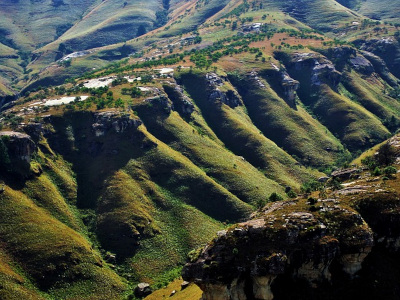Have you ever stood in front of an enormous mountain and wondered how it is possible for stones to take on a shape like that? Mountainous islands have always been impressive to me, especially since living on one. If you are interested in how the different types of mountains have formed over the last millions of years and how they still change today, then keep reading!

Volcanic Mountains
Volcanic Mountains form when one tectonic plate pushes beneath another which causes a crack in the earth’s crust. Magma gets forced to the surface and can escape through the opening. The cooled-down magma in combination with volcanic ashes and other gases forms a mountain. This process of creating a mountain takes thousands of years and can also appear in the ocean in form of an island. If the Magma coming to the surface consists of cinders – pebble-like structures – it ultimately forms a steep mountain which is called a cinder cone volcanic mountain. If the magma on the other hand is low in viscosity and covers a big area, a wide mountain, called a shield mountain, is formed. An example is Mount Fiji in Japan.

Fold Mountains
When two tectonic plates collide, it might happen that the rocks and debris between are warped which creates a folded mountain. These types of mountains are mostly found at convergent plate boundaries where two plates can collide. The rocks on the edges of those plates are less stable which makes it easier for them to fold and warp. Great examples are the Jura Mountains in the Alps or the Himalayan mountain chain. The latter originates from the collision of the Indian subcontinent and Asia around 25 million years ago.

Block Mountains
Block Mountains can form in three different ways. The first possibility is an upward movement of a middle block between two stable parts. The higher part is also called a horst and these mountains are usually very steep. As a second option, two blocks could also move down while the middle part remains stable. In the last scenario, the middle part moves downward and the two sides become Block Mountains. An example is the Black Forest in Germany.
Mountain Erosion
When a mountainous region is newly formed, erosions like wind, water, ice, or gravity have a big impact on it. Wind wears down the rocks and sediment can be transported by lakes. The erosions lead to for example peaks or bowl-shaped depressions which can also be a lake. After millions of years of erosion mountains can even fully disappear. In general, vegetation protects mountains from being worn down by erosion. Since the air gets colder as it gets higher, in the upper parts of a mountain the chance for vegetation is a lot lower which makes it more vulnerable to erosion.
The formation of mountains has been around for way longer than any form of human life and will outlive us by far. It’s intriguing and there is so much more interesting to find out. I hope you learned something new through this article!
Sources:
https://www.nationalgeographic.com/science/article/mountains
https://www.universetoday.com/29833/how-mountains-are-formed/
https://sciencestruck.com/how-are-volcanic-mountains-formed
https://www.toppr.com/guides/EVS/natural-disaster/volcanic-mountains-characteristics-types-examples/
https://www.insightsonindia.com/world-geography/physical-geography-of-the-world/geomorphology/folding-faulting-isostasy/fold-mountains/how-are-fold-mountains-formed/
https://www.insightsonindia.com/world-geography/physical-geography-of-the-world/geomorphology/second-order/mountains/types-of-mountains/original-or-tectonic-mountains/block-mountains/how-are-block-mountains-formed/
https://www.scientificamerican.com/article/how-erosion-builds-mountains-2005-07/
